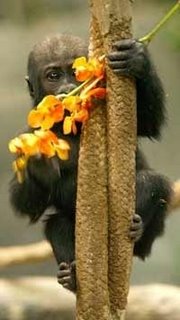
From Making a Killing to Saving a Species:
A Profile of Thomas Kaplan
by Diane Garcia and Erik Stokstad
A retired financier turned philanthropist is making an unprecedented investment in conservation science to help save the big cats.
Thomas Kaplan was a long way from his usual Wall Street habitat. The wealthy financier spent 4 days last year tracking a 3-year-old leopard named Ngoye in the humid woodlands of northern KwaZulu-Natal Province in South Africa. Along with Luke Hunter, a wildlife biologist for the New York-based
Wildlife Conservation Society (WCS), and Guy Balme, a graduate student at the
University of KwaZulu-Natal, Durban, Kaplan was silently willing Ngoye to cross from private lands, which were off-limits to the trio, into the
Phinda Game Reserve so they could replace her radio collar. Just as they were about to give up and head back to Cape Town, Ngoye finally entered the reserve. Balme quickly tranquilized her and replaced her collar.
The trek turned out to be a pivotal experience--and not just for the 43-year-old Kaplan, who was fulfilling a lifelong dream to study big cats. After he learned that Balme was struggling to find the money to complete his master's degree, Kaplan wrote a $20,000 check to cover Balme's expenses for 2 years. That philanthropic act was just the start: Kaplan decided there and then to launch a grants program with WCS for graduate students working on cat conservation. So far, he has given $307,000 to 20 students at institutions all over the world, with a goal of spending $500,000 a year. Balme says he now plans to pursue a Ph.D. in zoology.
Graduate students aren't the only beneficiaries of Kaplan's largess. Since his trek, Kaplan has pledged $13 million over 10 years for a variety of cat-related conservation efforts, making him quite possibly the largest individual source of research support for such efforts around the world. Conservation scientists say that his long-term philanthropic commitment promises not only to give them more tools with which to save these magnificent beasts but also to nurture the next generation of conservationists. "I don't think anyone else is in this bracket," says conservation biologist John Seidensticker of the
Smithsonian Institution's National Zoo in Washington, D.C.
Cat loverKaplan, who grew up in New York City, says books such as Jim Corbett's The Man-Eating Leopard of Rudraprayag fueled his passion for big cats. By the age of 11, he had tracked bobcats in Florida, sighted a panther, and searched for jaguars in the Amazon. "Their gait is self-assured, their bearing confident, their coats are brilliant and practically glow with the richest hues," he enthuses.
Despite his interest in animals, Kaplan decided to make his mark in the financial world. After finishing a Ph.D. in history from
Oxford University, Kaplan managed hedge funds before founding Apex Silver Mines in 1993. Helped by an investment from the Soros family, Apex became one of the world's largest silver-mining companies; Forbes magazine estimated that Kaplan's 20% stake in the company was worth $70 million in 2000. In late 2004, Kaplan retired from Apex; since then, he has founded an energy company and another firm that explores for precious metals around the world.
However, those interests leave him plenty of time for philanthropy. He endowed The Lillian Jean Kaplan Renal Transplantation Center at the
University of Miami, Florida, after his mother died of kidney disease in 2002 and helped set up a prize for research on the disease.
Kaplan was introduced to modern conservation efforts through reading Jaguar, a book by WCS wildlife biologist Alan Rabinowitz about setting up the world's first jaguar preserve in Belize. "I felt an immediate, indeed, filial, affection for the man and a knowing connection to the depth of his passion," Kaplan says. "I resolved one day to help him fulfill his biggest ambitions in the way that he had unknowingly lived all of mine."
After leaving Apex, Kaplan called Rabinowitz, who suggested that Kaplan familiarize himself with WCS by visiting Hunter's project in South Africa. "I've dealt with donors since 1978 … I could tell he was real," Rabinowitz says. "It's very rare for someone to say big cats have been a lifelong passion."
Setting targetsExperts warmly welcome Kaplan's decision to continue supporting the work of students he has funded. Explains Seidensticker: "The problem for many graduate students is that they get a degree, go back to their countries, and there are no support bases. They get drawn away from the field." The 20 graduate students currently receiving funding are conducting research on wild cats in Africa, Asia, Central and South America, and elsewhere.
Their projects include a conservation plan for the 15 remaining Armenian leopards and a study of how young cougars disperse through developed lands around Yellowstone National Park.
The scholarships are funded through Panthera, a foundation Kaplan created that is also contributing $10 million (half of it from Michael Cline, a venture capitalist in Greenwich, Connecticut) toward a conservation project in Asia called Tigers Forever. The project works with local governments and landowners to address conservation issues and is modeled after Rabinowitz's jaguar conservation program in Latin America. (In April, Rabinowitz helped persuade eight governments in the region to incorporate a jaguar corridor within the ongoing Mesoamerican Biological Corridor initiative, running from Mexico to Panama.)
The novelty of Tigers Forever, Rabinowitz says, is the setting of specific recovery targets--an average 50% increase over 10 years across the nine sites at which WCS works. "It holds our feet to the fire and makes us more accountable than anything ever done in conservation before," Rabinowitz says. "That's an extraordinary thing to do," says Seidensticker. Two months ago, Kaplan finalized plans with WCS for Project Leonardo, which will evaluate the status of lions in Africa and plan for their conservation. Kaplan and WCS have each committed $750,000 over 3 years for the effort, named for Kaplan's 4-year-old son, and he anticipates extending his commitment if the project meets its goals.
This fall, he plans to start an annual $50,000 lifetime achievement award for big cat conservation, joined next year by a $25,000 young scientist award in the field. With other projects in mind, Kaplan expects his commitment to top $20 million within 5 years. "I hope to collaborate with likeminded people who have passion for big cats," he says. "I'm willing to put serious money to get this done."
Photo: Tom Kaplan (left) helps Guy Balme change Ngoye's radio collar after sedating the leopard inside Phinda Game Reserve in South Africa.Photo credit: Luke Hunter, WCS



